
A monorail is a railway in which the track consists of a single rail or beam. Colloquially, the term "monorail" is often used to describe any form of elevated rail or people mover. More accurately, the term refers to the style of track. Monorail systems are most frequently implemented in large cities, airports, and theme parks.

A linear motor is an electric motor that has had its stator and rotor "unrolled", thus, instead of producing a torque (rotation), it produces a linear force along its length. However, linear motors are not necessarily straight. Characteristically, a linear motor's active section has ends, whereas more conventional motors are arranged as a continuous loop.
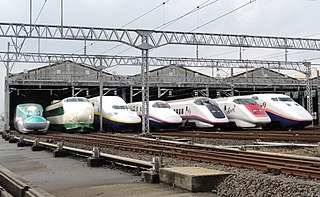
The Shinkansen, colloquially known in English as the bullet train, is a network of high-speed railway lines in Japan. Initially, it was built to connect distant Japanese regions with Tokyo, the capital, to aid economic growth and development. Beyond long-distance travel, some sections around the largest metropolitan areas are used as a commuter rail network. It is owned by the Japan Railway Construction, Transport and Technology Agency and operated by five Japan Railways Group companies.

Transrapid is a German-developed high-speed monorail train using magnetic levitation. Planning for the system started in the late 1960s, with a test facility in Emsland, Germany inaugurated in 1983. In 1991, technical readiness for application was approved by the Deutsche Bundesbahn in cooperation with renowned universities.

The Chuo Shinkansen is a Japanese maglev line under construction between Tokyo and Nagoya, with plans for extension to Osaka. Its initial section is between Shinagawa Station in Tokyo and Nagoya Station in Nagoya, with stations in Sagamihara, Kōfu, Iida and Nakatsugawa. Following the completion of the Tokyo–Nagoya line, the line will extend to stations in Mie, Nara and Osaka. The line is expected to connect Tokyo and Nagoya in 40 minutes, and eventually Tokyo and Osaka in 67 minutes, running at a maximum speed of 505 km/h (314 mph). About 90% of the 286-kilometer (178 mi) line to Nagoya will be tunnels.
Inductrack is a passive, fail-safe electrodynamic magnetic levitation system, using only unpowered loops of wire in the track and permanent magnets on the vehicle to achieve magnetic levitation. The track can be in one of two configurations, a "ladder track" and a "laminated track". The ladder track is made of unpowered Litz wire cables, and the laminated track is made out of stacked copper or aluminium sheets.

Maglev is a system of rail transport whose rolling stock is levitated by electromagnets rather than rolled on wheels, eliminating rolling resistance.
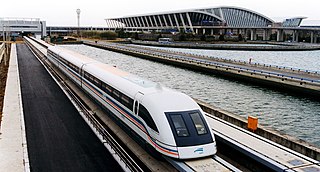
The Shanghai maglev train (SMT) or Shanghai Transrapid is a magnetic levitation train (maglev) line that operates in Shanghai, China. The line uses the German Transrapid technology. The Shanghai maglev is the world's first commercial high-speed maglev and has a maximum cruising speed of 300 km/h (186 mph). Prior to May 2021 the cruising speed was 431 km/h (268 mph), at the time this made it the fastest train service in commercial operation.

The SCMaglev is a magnetic levitation (maglev) railway system developed by Central Japan Railway Company and the Railway Technical Research Institute.
A vactrain is a proposed design for very-high-speed rail transportation. It is a maglev line using partly evacuated tubes or tunnels. Reduced air resistance could permit vactrains to travel at very high (hypersonic) speeds with relatively little power—up to 6,400–8,000 km/h (4,000–5,000 mph). This is 5–6 times the speed of sound in Earth's atmosphere at sea level.

Linimo, formally the Aichi Rapid Transit Tobu Kyuryo Line is a magnetic levitation train line in Aichi Prefecture, Japan, near the city of Nagoya. While primarily built to serve the Expo 2005 fair site, the line has since operated to serve the local community.
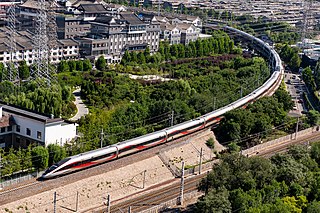
The high-speed rail (HSR) network in the People's Republic of China (PRC) is the world's longest and most extensively used – with a total length of 45,000 kilometres (28,000 mi) by the end of 2023. The HSR network encompasses newly built rail lines with a design speed of 200–380 km/h (120–240 mph). China's HSR accounts for two-thirds of the world's total high-speed railway networks. Almost all HSR trains, track and service are owned and operated by the China Railway Corporation under the brand China Railway High-speed (CRH).
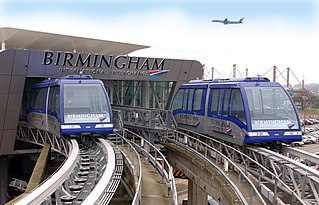
The Air-Rail Link is a people mover linking Birmingham Airport with Birmingham International railway station and the National Exhibition Centre in England. The current system, originally known as SkyRail, replaced the earlier Birmingham Maglev system in 2003.

The Guangzhou–Shenzhen–Hong Kong Express Rail Link (XRL), also known as the Guangshengang XRL, is a high-speed railway line that connects Guangzhou and Hong Kong (Kowloon) via Shenzhen. Officially, the line is the Guangzhou–Shenzhen–Hong Kong section of the Beijing–Guangzhou–Shenzhen–Hong Kong high-speed railway.
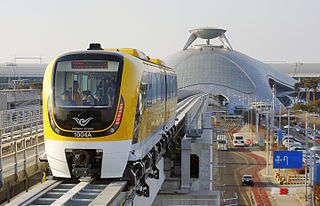
The Incheon Airport Maglev was a maglev line in South Korea that opened on 3 February 2016 and closed on 1 September 2023. It was the world's second commercially operating unmanned urban maglev line after Japan's Linimo. The trains were lighter, cutting construction costs in half. The majority of construction was completed by November 2012.

The L0 Series is a high-speed maglev train which the Central Japan Railway Company has been developing and testing. JR Central plans to use the L0 series on the Chūō Shinkansen railway line between Tokyo and Osaka, which is under construction.

Hyperloop is a proposed high-speed transportation system for both passengers and freight. The concept was published by Elon Musk in a 2013 white paper, where the hyperloop was described as a transportation system using capsules supported by an air-bearing surface within a low-pressure tube. Hyperloop systems have three essential elements: tubes, pods, and terminals. The tube is a large, sealed low-pressure system. The pod is a coach at atmospheric pressure that experiences low air resistance or friction inside the tube using magnetic propulsion. The terminal handles pod arrivals and departures. The hyperloop, in the form proposed by Musk, differs from traditional vactrains by relying on residual air pressure inside the tube to provide lift from aerofoils and propulsion by fans; however, many subsequent variants using the name "hyperloop" have remained relatively close to the core principles of vactrains.

Manufacturing USA, previously known as the National Network for Manufacturing Innovation, is a network of research institutes in the United States that focuses on developing manufacturing technologies through public-private partnerships among U.S. industry, universities, and federal government agencies. Modeled similar to Germany's Fraunhofer Institutes, the network currently consists of 16 institutes. The institutes work independently and together on a number of advanced technologies.

A proposed US$400 million magnetic levitation train system would have connected the Orlando International Airport and the Orange County Convention Center in Orlando, Florida, with a stop at the Florida Mall. The privately funded 13.8-mile (22.2 km) train line would be built by American Maglev Technology and was once expected to be operational by 2017. If completed, the train would have been the first commercial maglev system in North America.














